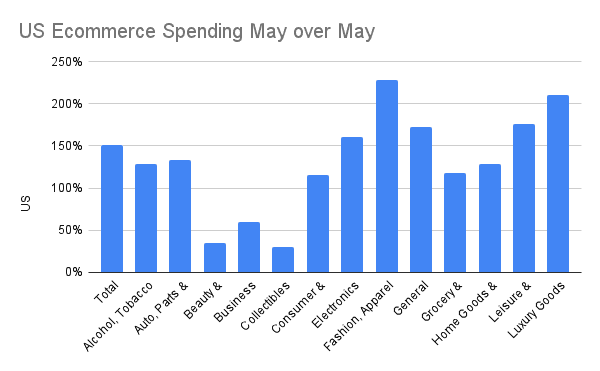The revival of retail is prominently featured in the Roaring `20s narrative that follows consumers’ return to normalcy, including by shopping in long-neglected brick-and-mortar stores as the COVID-19 pandemic subsides.
Less prominently on display is the rest of the story — the fact that an ecommerce boom unlike any in the history of retail continues to contribute to retail’s rise.
Online spending figures for May show ecommerce spending in the U.S. continues its torrid pace, with monthly sales closing 151% higher than they were a year ago, according to Signifyd Ecommerce Pulse data. And yes, there is a hint of the Roaring `20s in the numbers.
- Online apparel sales in May were up 228% year-over-year signaling that consumers are preparing to head back into the real world — where pants and shoes are required.
- Overall ecommerce spending was up 151% in May, a strong indicator that the habits consumers adopted during the height of the pandemic will endure.
- Consumers have big plans, based on Signifyd’s Ecommerce Pulse data. Online spending in May was up dramatically year-over-year in the Alcohol, Tobacco & Cannabis; Auto, Parts & Tires, Home Goods & Decor and Leisure & Outdoor retail verticals.
When we look at what consumers are spending on, it’s clear that many are ready to get going, let loose, be seen and be active. Many apparently are realizing that a move back to the office is going to require some changes. Time to wear pants and shoes again. In fact, online apparel sales were up 228% in May over May a year ago — a time when the reality of working from home for the duration was settling in.
But don’t make the mistake of concluding Americans emerging from their long confinement are all work and no play. A look at the retail categories with the biggest spending boosts, clearly indicates that happy days are here again. Or at least that there is a considerable focus on making these days happy.
Alcohol and cannabis spending indicates it’s party time
Cue the numbers: May spending in the Alcohol, Tobacco and Cannabis vertical was up 128% over a year ago. Of course, that could be an indication that it’s party time — or the spending could be a hedge against the adjustment of dealing so closely with all those co-workers again.
Yale professor Nicholas Christakis supports the party-time theory.
“Understandably, people will be very relieved when this is all finally over. People have been cooped one way or another for a very long time,” he told The Associated Press. “We’re going to see people relentlessly seeking out social opportunities in nightclubs and restaurants and bars and sporting events and musical concerts and political rallies.”
Christakis, author of “Apollo’s Arrow: The Profound and Enduring Impact of Coronavirus on the Way We Live,” is among the utmost authorities on post-pandemic life. He’s a sociologist, a medical doctor and a public health specialist. He told the AP that as the pandemic recedes into the fog of history that it’s going to be “a bit of a party.”
A look at the other high-performing verticals indicate a certain restlessness and optimism. The Luxury Goods vertical, which includes some high-end fashion, jewelry and the like, saw spending rise 211%. That could be a sign some are ready to get out of the town or maybe some just plan to look very good at work. Online sales in Auto, Parts & Tires was up 133%, a sign that consumers are ready to move, whereas a year ago the message from government and health officials was: You’re not going anywhere.
The great outdoors are looking great to consumers
Leisure & Outdoor spending increased by 176% over last year, continuing a torrid run of sales through most of the pandemic. Same with Home Goods & Decor, which saw a 129% month-over-month increase. Electronics sales were up 161%, indicating that consumers’ love affair with all things digital has not abated, even as IRL alternatives are beginning to become available.

It’s difficult to know whether May’s numbers are an indication that the party is just getting started or if the month will be an energetic blip boosted by a chorus of factors that created just the right conditions for free spending among those who avoided economic calamity in the pandemic.
It starts with the fact that by the end of May about half of the U.S. population had received at least one dose of the COVID-19 vaccine and that two in five were fully vaccinated. Consumers feel safer and more optimistic in general. Many, again the fortunate, have seen their bank accounts swell as they continued to work from home and avoided travel, dining out and spending on entertainment. Finally, the federal government’s injection of stimulus payments into the economy did just that — stimulated spending.
“The consumer is two-thirds of the GDP, and if you think that they’re not ready to spend money… They are, and it’s not just stimulus checks — people are just tired of being home,” Fashion Institute of Technology professor Shawn Grain Carter told Retail Dive.
All this online spending in May was happening at a time when physical stores were beginning to show serious signs of recovery. Strong earnings reports from large retailers including Target, Walmart, Home Depot and Macy’s combined sparkling financials with stories of consumers returning to stores.
Ecommerce remains strong despite consumers’ return to stores
“Every segment performed well, and we’re encouraged by traffic and grocery market share trends,”Walmart CEO Doug McMillon said in a statement accompanying the retail giant’s recent earnings report. “Our optimism is higher than it was at the beginning of the year. In the U.S., customers clearly want to get out and shop. We have a strong position as our store environment improves and ecommerce continues to grow.”
While foot traffic is no doubt picking up, the strength of ecommerce was a common theme in the earnings calls. Macy’s digital sales were up 34% year-over-year. Walmart saw ecommerce grow by 43% to where it now makes up 12% of company sales. Traffic on Target’s online store was up 17% while online basket size increased 5%. At Home Depot ecommerce sales increased 27%.
All that to say, while shoppers are returning to stores, they are not abandoning the habits they developed at the height of the pandemic. For instance, a significant number of those returning to stores are returning to pickup packages they ordered online.
In fact, sales involving buy online pick up in store or at the curb remained up 331% in May, compared to January 2020, according to Signifyd Pulse data.
Further evidence: The grocery category, which before the pandemic was a small sliver of online sales, continued to gain momentum in May. In fact, online sales of Grocery & Household Goods were up 118% year-over-year.
While the full picture of the new era of ecommerce is difficult to see from this early vantage point, it seems clear we’re headed to a future far from what we left behind before the pandemic arrived.
Photo by Mike Cassidy
We can help with your new era omnichannel challenges.











